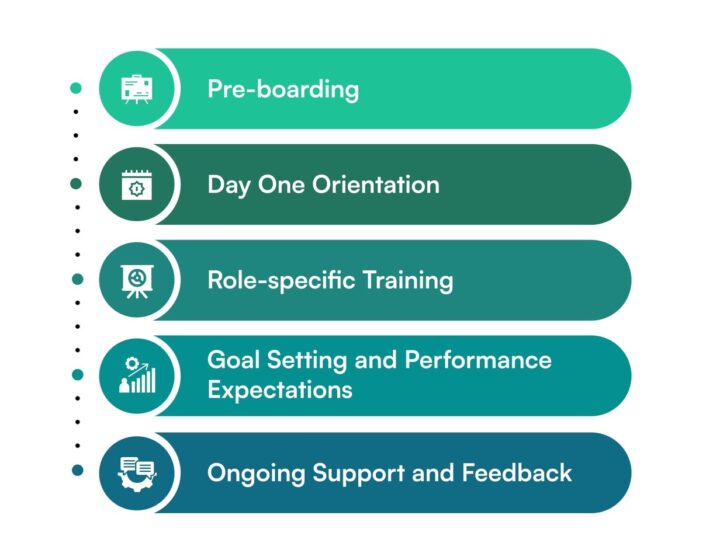The significance of effective onboarding remote employees cannot be overstated. It directly impacts employee engagement, productivity, and retention rates. A well-executed remote onboarding process can lead to faster time-to-productivity, improved job satisfaction, and a stronger sense of connection to the organization.
Remote onboarding serves as the foundation for an employee’s journey within an organization, shaping their initial perceptions and setting the tone for their entire tenure. It directly impacts several critical aspects of organizational success, with far-reaching consequences for both individual performance and overall business outcomes.
What is Onboarding Remote Employees?
Onboarding remote employees is a comprehensive, strategic process of integrating new hires into an organization. This process goes far beyond mere paperwork and introductions; it encompasses a holistic approach to orienting, and empowering new team members in a virtual setting.
At its core, remote onboarding leverages digital tools and platforms to create a seamless, engaging experience that mirrors and often enhances traditional in-person onboarding.
The digital aspect of remote onboarding involves the use of video conferencing for face-to-face interactions, project management tools for task allocation and tracking, learning management systems for training and development, and collaboration platforms for team communication and document sharing. These digital tools form the backbone of the remote onboarding experience, creating a virtual environment that simulates the connectedness of a physical workplace.
Remote Onboarding Process: A Strategic Approach
The remote onboarding process requires a strategic, multi-phased approach to ensure comprehensive integration of new employees. Here’s a detailed breakdown of the key steps:

Pre-boarding
The pre-boarding phase begins before the official start date. HR teams should send a comprehensive welcome package to the new hire, containing a detailed schedule for the first week, login credentials for necessary platforms, and the company handbook with policy documents. It’s crucial to configure and ship necessary hardware, such as laptops and headsets, well in advance. Setting up virtual meet-and-greets with key team members helps build initial connections. Providing access to a pre-onboarding portal with introductory materials allows the new hire to familiarize themselves with the company culture and expectations.
Day One Orientation
The first day should include a virtual welcome session led by HR and leadership. This session provides a comprehensive overview of the company’s history, mission, and strategic objectives. It’s important to explain the organizational structure, introduce key stakeholders, and clarify the remote work culture and expectations. A virtual tour of digital workspaces and collaboration tools helps new hires navigate their virtual environment. Allocate time to address any immediate questions or concerns, ensuring new employees feel supported from day one.
Role-specific Training
Implement a structured training program tailored to the new hire’s role. This should utilize a mix of synchronous and asynchronous learning methods, including live virtual training sessions, self-paced e-learning modules, and interactive simulations or case studies. Assigning a subject matter expert as a virtual mentor provides personalized guidance. Establish clear milestones and learning objectives, and conduct regular check-ins to assess progress and address any challenges that arise during the training process.
Goal Setting and Performance Expectations
Schedule a dedicated session with the direct manager to define short-term and long-term goals, establish key performance indicators (KPIs), and clarify reporting structures and communication protocols. Implementing a digital goal-tracking system enhances transparency and accountability. Regular virtual check-ins should be set up to review progress and provide feedback, ensuring the new hire stays aligned with team and company objectives.
Ongoing Support and Feedback
Implement a structured feedback system with regular touchpoints, including weekly check-ins for the first month, bi-weekly check-ins for the following two months, and monthly check-ins thereafter. Utilize digital surveys to gather quantitative and qualitative feedback on the onboarding experience. Regularly analyze onboarding metrics to identify areas for improvement. The onboarding process should be continuously adjusted based on collected data and feedback, ensuring it remains effective and relevant to the changing needs of new hires and the organization.
The cost of HR in an organization is directly affected by the onboarding and retention of remote employees. Our research indicates that ineffective onboarding processes may impact recruitment, resulting in a 24% increase in turnover.

Best Practices for Onboarding Remote Employees
Implementing effective strategies for employee onboarding services is crucial for ensuring new hires’ success and long-term engagement. Consider the following best practices.
Create a detailed 90-day onboarding plan with clear milestones and objectives. Implement a digital onboarding checklist accessible to both the new hire and HR. Develop role-specific onboarding tracks tailored to different departments and seniority levels. Establish clear ownership and accountability for each stage of the onboarding process.
Develop a searchable, digital knowledge base covering all aspects of company operations. Create interactive, multimedia onboarding materials including videos, infographics, and podcasts. Offer access to industry-specific training and certification programs. Provide digital guides on remote work best practices and productivity tips.
Implement a formal mentorship program pairing new hires with experienced employees. Create virtual “water cooler” spaces for informal interactions and relationship building. Organize regular virtual team-building events and social activities. Encourage participation in online employee resource groups and interest-based communities.
Utilize pulse surveys to gather real-time feedback throughout the onboarding process. Implement a digital suggestion box for ongoing improvement ideas. Conduct virtual focus groups with recent hires to identify pain points and success factors. Establish key performance indicators (KPIs) for onboarding success and track them consistently.
This approach not only facilitates smooth integration into the company but also enhances employee engagement, productivity, and retention in the long term. As remote work continues to evolve, regularly reviewing and refining these practices will be crucial to maintaining an effective and competitive onboarding process.
Onboarding Remote Employee with GEOR
GEOR offers employee onboarding services designed to optimize the remote integration process. Our onboarding services begin with thorough organizational assessments to identify specific requirements, followed by the development of customized strategies aligned with the client’s culture and objectives.
Do you need a team of IT specialists in the US and worldwide? Contact GEOR; we will take care of all recruitment, onboarding, payroll, taxes, and other processes.
Conclusion
Remote onboarding has emerged as a critical business process. It requires a thoughtful, structured approach that leverages technology to create a welcoming and informative experience for new hires. The importance of this process extends far beyond the initial days of employment, shaping the trajectory of an employee’s entire tenure with the organization.
The transition to remote work has amplified the significance of effective onboarding. In a virtual environment, the onboarding process becomes the primary means of integrating new employees into the organizational fabric. It sets the tone for their experience, establishes expectations, and lays the foundation for long-term success and engagement.
While there are costs associated with employee onboarding, especially in a remote context, these should be viewed as strategic investments.




